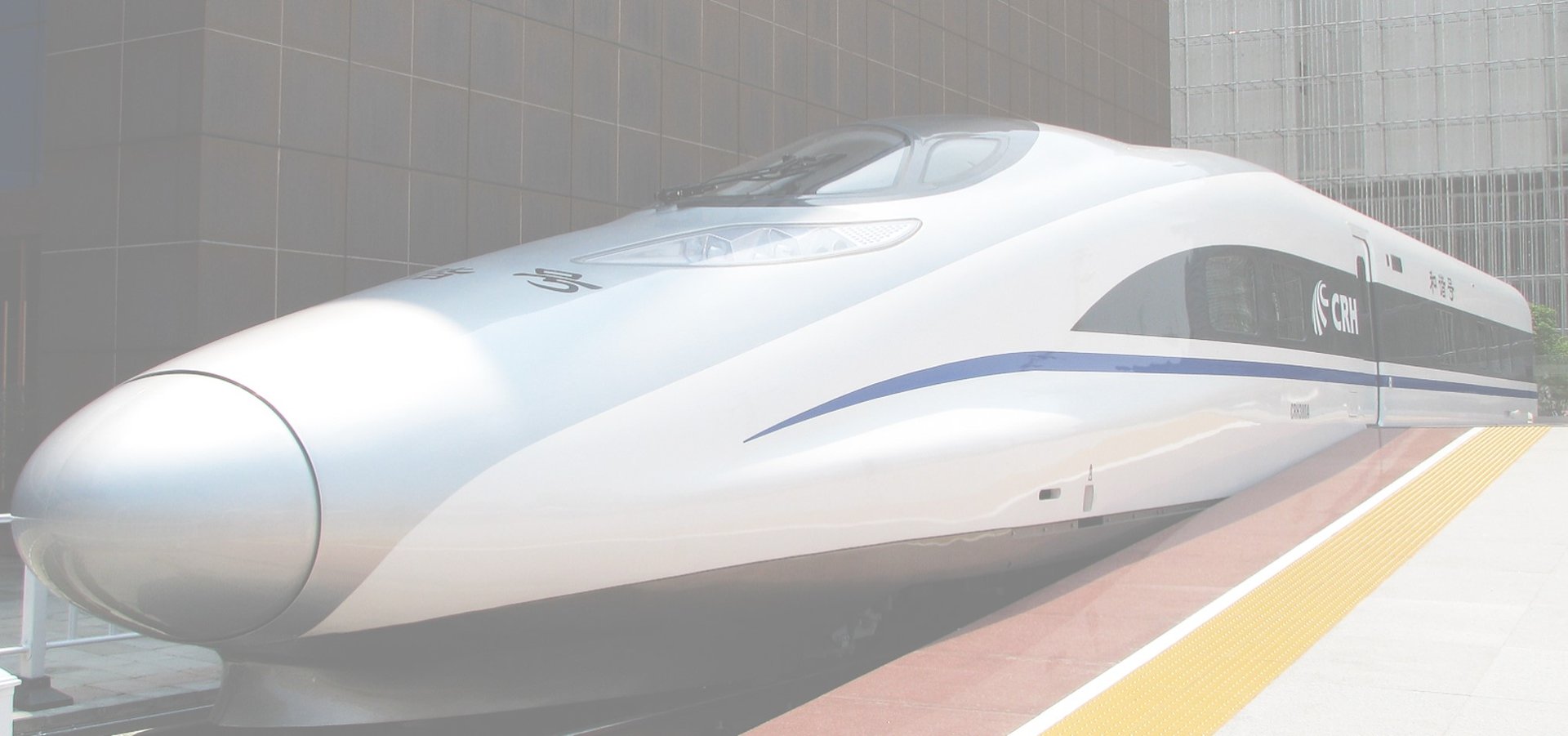
How Did China Quickly Get High-speed Train Technology?
Before 2004, China's attempts to independently develop high-speed railways were largely unsuccessful, and the country's rail transportation primarily relied on traditional vehicle models to transport passengers. However, by 2022, China had developed high-speed trains that could be exported, and was operating hundreds of high-speed trains on its network, which accounted for two-thirds of the world's high-speed railways.
Jiesen Bababa & CathayViews (Trans. & Ed.)
6/15/202319 min read


Time flies, and 40 years later, when China's standard high-speed train "Fuxing" races on the vast land of China, high-speed trains have become China's golden business card. Where does China's high-speed train technology come from? And how did it come about? This essay will interpret this classic case that has been written into American Stanford University textbooks.
In October 1978, Deng Xiaoping(邓小平) experienced riding on the Shinkansen during his visit to Japan and said with deep feeling, "I feel the speed and the urge to run. We need this kind of train now."
Deng Xiaoping(邓小平, 1904-1997) gradually rose to supreme power after 1978, and led China through a series of far-reaching market-economy reforms, earning him the reputation as the "Architect of Modern China".
Image from Wikipedia. For more, see
https://en.wikipedia.org/wiki/Deng_Xiaoping
The Fuxing high-speed trains can achieve the operation of different train types with the same speed level running in formation, and mutual rescue between train types with different speed levels, compared to the previous joint production of high-speed trains with foreign manufacturers. It also breaks the restriction that the purchased patents are only valid in China and cannot be used for exporting high-speed trains, making it possible for China to sell high-speed train systems to the world.
Image from Wikipedia. For more, see
https://en.wikipedia.org/wiki/Fuxing_(train)
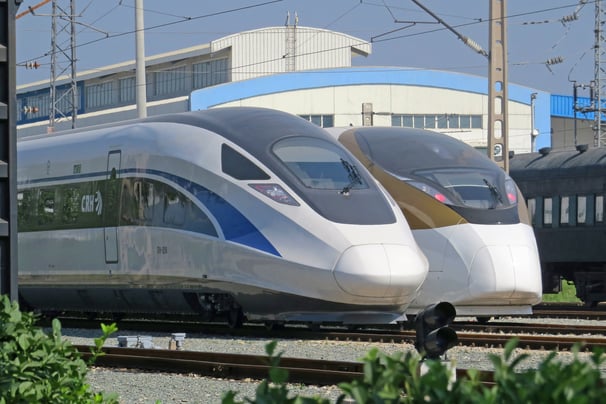

1. The Beginning of Technical Cooperation
From 1997 to 2004, China's railway experienced five major speed increases. The speed of national railway passenger trains gradually increased from 48.1 kilometers per hour to 65.7 kilometers per hour, and some sections of the main lines have the conditions for a speed of 200 kilometers per hour. At the same time, domestically developed high-speed trains such as the DJJ1-Blue Arrow(“蓝箭”), DJJ2-China Star(“中华之星”), and DJF1 Zhongyuan Star(“中原之星“) were put into operation one after another, but the pace of technological progress could not keep up with the speed increase of the railway.
In 2004, the then Ministry of Railways began planning for the sixth major speed increase of China's railways and laid the foundation for achieving a breakthrough in high-speed train development through the introduction of advanced foreign technologies. On June 17th, the Ministry of Railways issued an invitation for bids for the high-speed train project with a speed of 200 kilometers per hour, marking the beginning of a great power game in high-speed trains. This was an invitation that changed the history of China's high-speed train development.
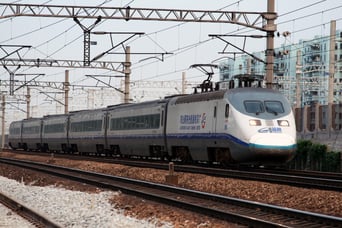



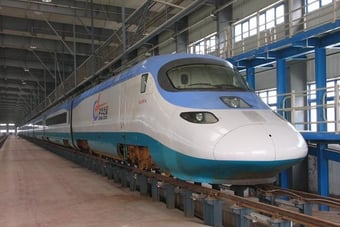

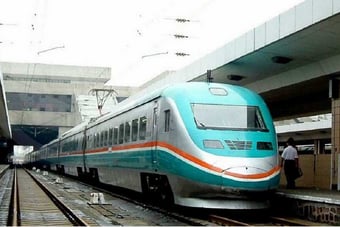

DJJ1 “Blue Arrow". Image from Wikipedia, see https://zh.wikipedia.org/wiki/DJJ1%E5%9E%8B%E7%94%B5%E5%8A%9B%E5%8A%A8%E8%BD%A6%E7%BB%84 (Web page in Chinese)
DJJ2 “China Star", image from Wikipedia, see https://zh.wikipedia.org/wiki/DJJ2%E5%9E%8B%E7%94%B5%E5%8A%9B%E5%8A%A8%E8%BD%A6%E7%BB%84 (Web page in Chinese)
DJF1 “Zhongyuan Star", image from https://china-emu.cn/EMUs/Model/?detail-80002-101-F.html
(Web page in Chinese)
After these trains were put into operation, they gradually exposed some quality problems, and even stopped during operation, seriously affecting punctual operation.
As the successor of the People's Liberation Army Railway Department and Railway Troops, the former Chinese Ministry of Railways had a dual identity as both the "national railway operator" and the "railway transportation regulatory authority", and had a special relationship with railway public security. In the 2012 Chinese central government institutional reform, the enterprise function of the Ministry of Railways was split into the independent "China Railway Corporation" (now the "China State Railway Group"), and the regulatory function was transferred to the "National Railway Administration" under the Ministry of Transport.
For more, see https://en.wikipedia.org/wiki/Ministry_of_Railways_(China) and https://zh.wikipedia.org/wiki/%E5%9B%BD%E5%AE%B6%E9%93%81%E8%B7%AF%E5%B1%80 (Web Page in Chinese)
The wisdom of the Ministry of Railways is reflected in the three thresholds set in the invitation letter. The first is the requirement for the qualifications of the bidders, as follows:
"Bidding companies must be legally registered within the territory of the People's Republic of China, possess the ability to manufacture high-speed railway trains, and have obtained technical support from foreign partners with mature design and manufacturing technology for high-speed railway trains with a speed of 200 kilometers per hour. This includes Chinese manufacturing enterprises, including joint ventures with foreign partners."
This sentence is quite complicated. In simpler terms, it means the following two points:
The bidding enterprise must be a Chinese enterprise. Can foreign enterprises bid directly? No way.
if Chinese companies do not have access to mature technology support from abroad, they cannot participate in bidding, which blocks all domestically independently developed high-speed trains from entering the market. This clearly indicates that foreign companies can only enter the Chinese market by seeking cooperation partners in China.
The designated domestic partners appointed by the Ministry of Railways are only two companies: one is CSR Corporation Limited's subsidiary, CSR Qingdao Sifang Co., Ltd., the other is China CNR Corporation Limited's subsidiary, Changchun Railway Vehicles Co., Ltd.
However, there are 4 companies from Germany, Canada, France, and Japan that are eyeing the opportunity abroad. The situation of 2 against 4 means that in order to cooperate, there must be some sincerity.
The second hurdle of the Ministry of Railways is to clearly stipulate the three principles of cooperation, namely, the key technology must be transferred, the price must be the lowest, and Chinese brands must be used.
Some readers may ask: Were those foreigners stupid? The Chinese wanted to learn other people's skills without paying tuition, and in the end, they don't even recognize their teachers. Who would come to bid?
In fact, no one was stupid. However, these companies understand that although this tender is only for 140 high-speed train sets, it represents a large cake behind it - the "Four Horizontal and Four Vertical" high-speed railway network outlined in China's medium and long-term railway planning. No one dares to easily let go of this opportunity.


China National Railway Locomotive & Rolling Stock Industry Corporation (LORIC, 中国铁路机车车辆工业总公司) used to be the only railway locomotive and rolling stock manufacturer in mainland China, with more than ten factories distributed throughout the country. Before 1988, it was a department under the jurisdiction of the Ministry of Railways; after 1986, it changed its name to LORIC and became a state-owned enterprise.
In 2000, in order to promote competition among locomotive and vehicle manufacturing enterprises and improve their efficiency, the Chinese government split LORIC into two companies, CNR (China Northern Locomotive & Rolling Stock Industry (Group) Corporation) and CSR (China South Locomotive & Rolling Stock Corporation Limited).
Due to the vicious competition and malicious price-cutting between the two companies in overseas railway equipment market, the Chinese government decided to re-merge the two companies in 2014 and establish CRRC.
For more, see https://zh.wikipedia.org/wiki/%E4%B8%AD%E5%9B%BD%E5%8D%97%E8%BD%A6#%E4%B8%AD%E5%9B%BD%E5%8D%97%E8%BD%A6%E8%82%A1%E4%BB%BD%E6%9C%89%E9%99%90%E5%85%AC%E5%8F%B8 (Web Page in Chinese) and https://zh.wikipedia.org/wiki/%E4%B8%AD%E5%9B%BD%E9%93%81%E8%B7%AF%E6%9C%BA%E8%BD%A6%E8%BD%A6%E8%BE%86%E5%B7%A5%E4%B8%9A%E6%80%BB%E5%85%AC%E5%8F%B8 (Web Page in Chinese)


The centerpiece of the Ministry of Railways' expansion into high-speed rail is a national high-speed rail grid that is overlaid onto the existing railway network. The 2004 Railway Network Plan called for four lines running north-south (verticals) and four lines running east-west (horizontals) by the year 2020 that would connect population centers in economically developed regions of the country.
Afterwards, the "Four Horizontal and Four Vertical" plan was replaced by the "Eight Horizontal and Eight Vertical" plan, which became the basic framework of China's high-speed railway network today.
Image from Wikipedia, see https://en.wikipedia.org/wiki/High-speed_rail_in_China#Development_and_social_impact
This bidding announcement is even more demanding than these, and the real cleverness lies in the third hurdle. The Ministry of Railways has cleverly set up an assessment called "technology transfer implementation evaluation", which means that after foreign companies complete technology transfer, the Ministry of Railways will assess whether domestic companies have learned real skills. As long as they haven't learned well, the Ministry of Railways won't give a penny. Isn't this typical of a big store bullying customers? Which teacher dares to boast that they can teach and train everything? If the student is not smart enough to learn well, can they still owe the teacher's salary?
Such harsh conditions ultimately led to successful cooperation, and one cannot help but admire the courage and foresight of the decision-makers at the time.
Although both industries aimed to introduce technology, the Chinese automotive industry ultimately failed in its attempt to "exchange the market for technology", as foreign brands occupied the market and Chinese companies did not obtain key technologies. On the other hand, the rail transit industry has been successful, and this invitation letter, which embodies the wisdom of the Chinese people, has played an indispensable role.
2. The First procurement: 200km/h Trains
From the announcement on June 17, 2004, to the bidding deadline on July 28, a total of 41 days passed. Four companies, Siemens from Germany, Alstom from France, Bombardier from Canada, and a Japanese consortium, competed fiercely. Among them, Bombardier had the least pressure because it had established a Sino-foreign joint venture with the former CSR Sifang Co., Ltd. in Qingdao as early as 1998, called BSP company. This company was both a Chinese enterprise and owned advanced foreign technology, fully meeting the requirements of the Ministry of Railways for bidding entities. As a result, only Siemens from Germany, Alstom from France, and the Japanese consortium were left to compete for the two spots.
The Japanese consortium focused on the CSR Sifang, while Siemens focused on the CNR Changchun. Only Alstom was simultaneously straddling both boats.
Let's first talk about the alliance between CSR Sifang and Japanese companies.
CSR Sifang initially hoped to introduce the latest technology of Japan's Shinkansen 800 series, but JR East, Hitachi, and J-TREC all strongly opposed transferring the technology to China. It was thought that the story ended there, but unfortunately, at this time, Japanese company Kawasaki Heavy Industries, with a century-long history, was experiencing a business downturn, and this tender from the Ministry of Railways was a lifeline for them.
Under the lobbying of Kawasaki Heavy Industries, a consortium of Japanese companies including Kawasaki Heavy Industries, Mitsubishi Corporation, Mitsubishi Electric, Hitachi, Itochu Corporation, and Marubeni Corporation ultimately formed and negotiated with CSR Sifang.
The Japanese companies were not philanthropists. They did not offer their best technology, but rather a castrated version of the E2-1000 Shinkansen that was introduced 7 years ago. Negotiations between the two sides did not go smoothly, with the Japanese side making several attempts to threaten to terminate the talks. However, China South Rail was not to be underestimated and knew that the Japanese were bluffing. One day, when the Japanese side threatened once again, a Chinese representative smashed his tea cup on the ground and warned, "If you walk out of that door today, don't ever come back." Although this was somewhat impolite, the Japanese ultimately did not dare to leave through that door and obediently returned to continue the negotiations.
As for Alstom, CSR Sifang did not initially intend to purchase their technology because Alstom specializes in centralized power train high-speed trains, and their decentralized power train AGV was still only on paper in 2004, or more accurately, the paper was not even known to exist. At that time, the Ministry of Railways only wanted to introduce decentralized power train high-speed trains.
Following Alstom's design style, the AGV will also be a tilting train with Jacobs Bogies. The Ministry of Railways was not interested in such a train. Negotiations between CSR Sifang and Alstom were mainly aimed at pressuring the Japanese consortium to lower their price.
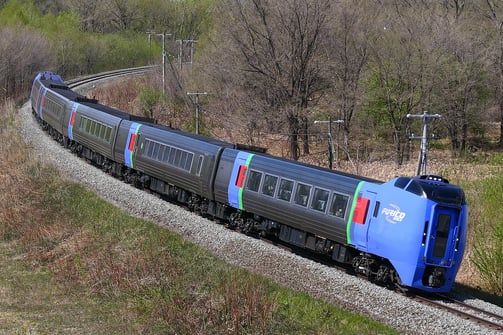

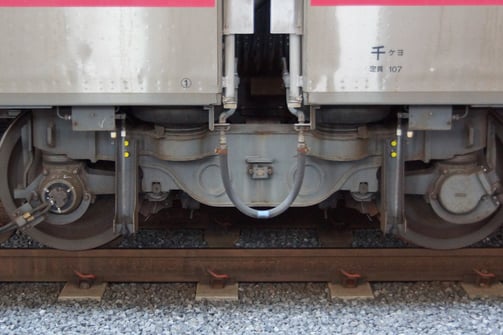

A tilting train is a type of train that can enhance lateral swaying during body turning, contrary to the inherent design of the railway track. Compared to ordinary trains, tilting trains can travel beyond the track design speed when passing through low-angle curves designed for slower trains, thereby saving travel time. The downside is that maintenance costs for the train and track will increase.
The Chinese Ministry of Railways had planned from the beginning to completely build a high-speed railway dedicated to passenger transport, in order to make up for the insufficient coverage and low level of existing railways. Therefore, the design of swing trains, which were mainly intended to improve the speed of existing railways, was not useful for China.
Image from Wikipedia, see https://en.wikipedia.org/wiki/Tilting_train
Jacobs bogies refers to the design of using the same bogie to connect the bogies of adjacent carriages. This design helps to reduce the number of bogies, reduce noise, lighten the weight of the train, and enable the train to pass through more curved railways.
However, for the distributed power system of the multiple-unit train, the wheels of multiple carriages are connected to the motor to provide power. The reduction in the number of wheels means a decrease in the total output power. In addition, fewer bogies mean that a single bogie needs to bear greater weight and requires the use of higher-strength materials, which was very difficult for China at that time.
Image from Wikipedia, see https://en.wikipedia.org/wiki/Jacobs_bogie
Take a look at the partnership between CNR Changchun and Siemens. The Germans were more practical than the Japanese, offering the world's most advanced distributed power train technology based on the ICE3, which was developed into the Velaro platform. However, good products are not cheap, and at the time Siemens believed they had the upper hand, so they demanded a sky-high price. The prototype cost 350 million RMB per train, and the total technology transfer fee was 390 million euros.
Using the exchange rate at that time, the technology transfer fee alone was 7 times the price demanded by the Japanese consortium.
Originally, the negotiations between CNR and Alstom were just for show, but because Siemens kept refusing to lower their prices, it forced CRRC and Alstom to start playing for real just half a month before the bidding deadline. Alstom's example tells us that as long as we persist, even backup options can become the main choice.
The day before the bidding, Zhang Shuguang (张曙光), former Deputy Chief Engineer of the Transportation Bureau of the former Ministry of Railways, personally negotiated with Siemens and set the bottom line for the Ministry of Railways: the price of each train should be less than 250 million yuan and the technology transfer fee should be less than 150 million euros. The Siemens representative was clueless and refused to give face to the Chinese side. Zhang Shuguang smiled and said, "You can book your tickets back to your country now," and then turned and left.
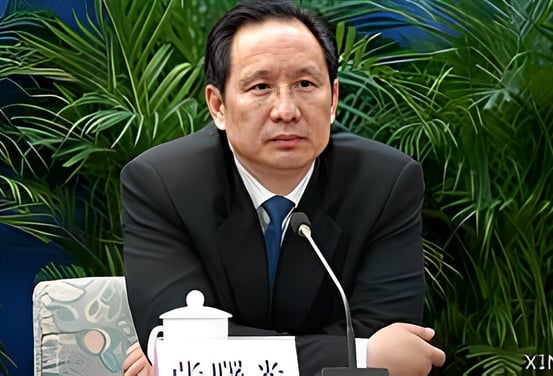

Zhang Shuguang (张曙光,born December 25, 1956) is a male railway engineer and politician from Liyang, Jiangsu Province, China. He was the former Deputy Chief Engineer and Transport Bureau Director of China Railway. He was responsible for designing major national projects and mega-projects such as China's high-speed trains (technological importation and localization), Qinghai-Tibet passenger trains, new generation high-power AC electric locomotives and diesel locomotives, and passenger dedicated line system integration. He is known as the "Father of China's High-Speed Train Technology".
In 2014, Zhang Shuguang was sentenced to death with a two-year reprieve for accepting bribes, deprived of political rights for life, and all of his personal property was confiscated. Two years later, he was commuted to life imprisonment.
Image from Xinhua News Agency.
On the morning of July 28, 2004, at 7 o'clock, when the Siemens representative was still confident and prepared to bid with CNR Changchun, he was informed that CNR Changchun had ultimately chosen Alstom.
At this point, the Germans were just waking up from a big dream. As they gave up the world's largest market, Siemens' stock plummeted, and the responsible executives submitted their resignations, while the negotiating team was collectively fired.
The final bidding result is that the CSR-Sifang and the Japanese consortium won the bid with a modified version of the E2-1000-type high-speed train, which was later named CRH2A.
The CNR-Changchun and Alstom used the Pendolino wide-body tilting train as a basis, and the body was modeled after the Italian railways ETR600/610 high-speed train to create a new train model. They won the bid for 60 trains and later named it the CRH5A high-speed train.
Bombardier’s joint venture company between CSR Sifang, BSP(Bombardier Sifang (Qingdao) Transportation Ltd), won the bid for 20 sets of Regina C2008 type high-speed trains, which were later renamed as CRH1A. Siemens' failure resulted in both China and Germany losing out, as Siemens was unable to enter the Chinese market and the Ministry of Railways was unable to acquire the desired technology.
Subsequent practice has also proved that among the three types of vehicle technologies introduced this time, the weakened version of the e2-1000 Shinkansen technology provided by Japan performed the best.
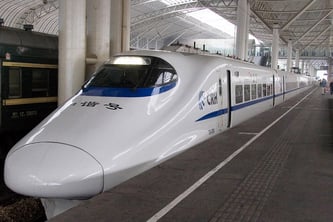



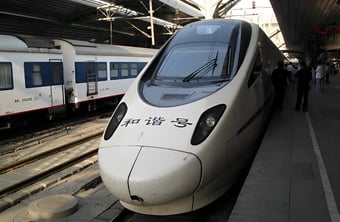

CRH2A. Image from Wikipedia, see https://en.wikipedia.org/wiki/China_Railway_CRH2
CRH5A, image from Wikipedia, see https://en.wikipedia.org/wiki/China_Railway_CRH5
CRH1A, image from Wikipedia, see
https://en.wikipedia.org/wiki/China_Railway_CRH1
3. The Second procurement: 300km/h Trains
The claim that the Ministry of Railways has achieved a leapfrog development is not an exaggeration at all. Only 10 months after the first bidding results were announced, the Ministry of Railways officially launched the procurement of high-speed trains with a speed of 300 kilometers per hour in June 2005. This is a remarkable concept. It should be noted that the first domestically produced high-speed train CRH2A did not come off the production line until July 31, 2006, and the shadow of the 200-kilometer-per-hour train had not yet been seen, but the Ministry of Railways was already eager to launch the 300-kilometer-per-hour train.
The speed level has stepped up, but there aren't many enterprises that have mastered the related technology. Let's take a look at who had the technology for 300 km/h high-speed train sets in 2005 around the world.
The first potential competitor, Siemens from Germany, is definitely qualified! The Siemens ICE3, which was put into operation in 2000, was the most advanced 300 km/h distributed power train in the world at that time. As we mentioned in the last bidding, the Ministry of Railways has long coveted the Velaro platform developed based on the ICE3. Having learned from the previous failure, Siemens is also prepared to go all out this time.
The second example is the Japanese Shinkansen, which also has the qualification. The 500 series Shinkansen of the Tokaido family, which commenced operation in 1997, and the N700 series Shinkansen, which began design in 2002, both have a design and operating speed of 300 kilometers per hour. However, the Japanese company Hitachi, which manufactures these trains, refused to transfer its technology to China. In addition, in 2005, Japan had a controversy over the alteration of history textbooks, which sparked anti-Japanese sentiment in China. As a result, the Ministry of Railways was not willing to pursue this any further.
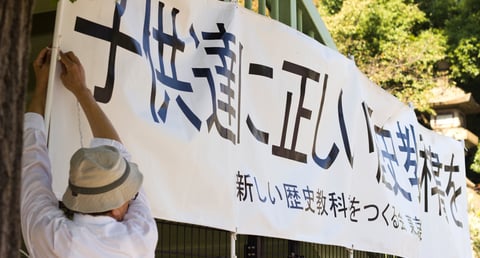

The controversy surrounding Japanese history textbooks refers to the disputes surrounding domestic history textbooks in Japan, mainly focusing on topics related to modern history, as well as issues related to the textbook screening and adoption process of the Japanese Ministry of Education. Since the Ministry of Education changed "invasion of China" to "entry into China" in 1958, similar incidents have continued to occur and are still ongoing.
The Japanese history textbook issue has not only attracted attention within Japan, but also from neighboring countries and regions such as Taiwan, Chinese mainland, Hong Kong, Macao, North Korea, South Korea, Russia, and some Southeast Asian countries. Western countries such as the UK, the Netherlands, France, and the US, which participated in the war in Asia as colonial powers, are also concerned about how Japanese history textbooks record and evaluate Japan's behavior during World War II.
In multiple editions of textbooks approved by the Japanese Ministry of Education, and even in textbooks that have been modified at the request of the Ministry, there are many controversial contents and writing techniques related to issues such as aggression against other countries, massacres, and forced sexual slavery, which have been opposed by many Asian countries and some Japanese citizens. Opponents of these textbooks believe that they exaggerate, glorify, and even distort Japan's traditional culture and its actions in Asia since the Meiji Restoration.
Images from Wikipedia.
see https://en.wikipedia.org/wiki/Japanese_history_textbook_controversies
and https://zh.wikipedia.org/wiki/%E6%97%A5%E6%9C%AC%E6%AD%B7%E5%8F%B2%E6%95%99%E7%A7%91%E6%9B%B8%E5%95%8F%E9%A1%8C (Web page in Chinese)

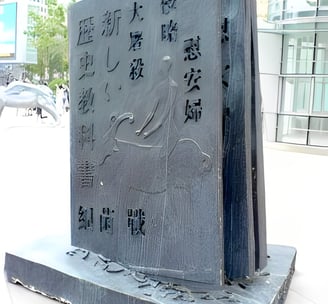
The third one, Alstom, can be considered as having attempted. In 2005, Alstom's distributed power AGV finally appeared on paper, with the completion of the design of the body and the front of the train. However, it was still a combination of a swinging train and articulated bogies, which the Ministry of Railways did not accept. Alstom said it was okay to change it, but the Ministry of Railways would smile and say, "Thank you, but last time the CRH5A you sold me with a hodgepodge of parts drove the designers at CNR and CSR crazy. Do you want me to make the same mistake again?"
The fourth place, Bombardier, really doesn't have it. Bombardier's high-speed train technology platform mainly has two, one is the Regina platform used by the CRH1A high-speed train, which Bombardier positioned as an intercity high-speed train with a designed speed of 180-200 kilometers per hour. Looking at its appearance, you can tell that it doesn't have the look of a high-speed train at all, and it looks more like a big subway train.
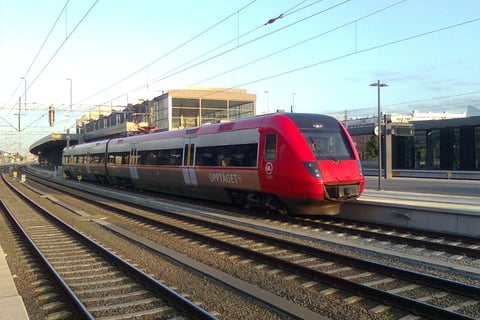



Regina train in Sweden. Image from Wikipedia. For more, see https://en.wikipedia.org/wiki/Bombardier_Regina
CRH1A in China. Image from Wikipedia. For more, see https://en.wikipedia.org/wiki/China_Railway_CRH1
Bombardier's another train platform, called ZEFIRO, is positioned as a high-speed train set, designed to run at speeds of 250-380 kilometers per hour. However, Bombardier only released the design concept of this platform to the public on April 13, 2005, which obviously couldn't catch up with the procurement by China Railway Ministry in the same year.
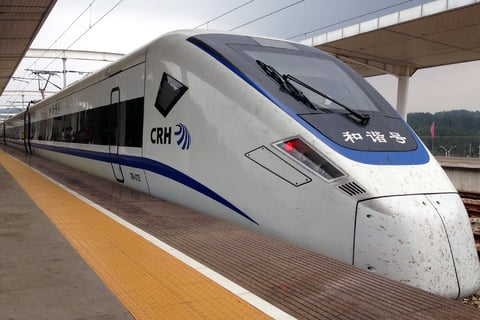

Later in 2009, Zefiro 250 were introduced to China, with the name CRH1E. CRH1E were designed as high-speed sleeper trains. Image from Wikipedia. For more, see https://en.wikipedia.org/wiki/Zefiro_(train)

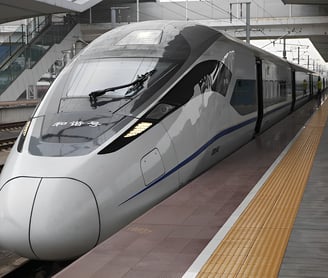
The advanced version of Zefiro were also introduced to China with the name CRH380D. Image from Wikipedia. For more, see https://en.wikipedia.org/wiki/China_Railway_CRH1#CRH380D
In fifth place is Italy's AnsaldoBreda, which was later acquired by Hitachi in 2015. Although its ETR500 high-speed train met the requirement of a speed of 300 km/h, it was a power centralized train, which was not suitable for China Railway.
The last one is the Spanish CAF, whose AVE Serie 100 high-speed train technology is derived from Alstom's TGV. It is a power-distributed train unit, but it does not have technology transferability and can only be abandoned.
Looking at the situation like this, it is not optimistic. The only company that has both technology and willingness to transfer is Siemens. If the Ministry of Railways conducts exclusive procurement, Siemens' quotation is likely to soar again. So what should the Chinese do?
Open bidding is no longer feasible, but we still need to gather two companies for competitive negotiations. At this point, the Ministry of Railways turned its attention to domestic companies. The CRH5A from CNR has no potential left to be tapped, but the CRH2A from CSR still had hope, as the pre-weakened E2-1000 model already had an operating speed of 275 kilometers per hour, just one step away from 300 kilometers per hour.
In this way, two sellers had come together. Let's take a look at the solutions they ha proposed.
First, let's talk about Siemens. Due to the advantage of 200 km/h technology, CRRC had the upper hand. In order to balance the power between the north and south, and not let one company dominate, the Ministry of Railways finally chose to negotiate with Tangshan Locomotive & Rolling Stock Works of CNR and Siemens. Learning from the failure of previous negotiations, this round of negotiations went more smoothly. The new Siemens representative showed the greatest sincerity, offering the Velaro platform with a prototype cost of 250 million RMB per train, and the technology transfer fee was reduced to 80 million euros. This was 70 million euros lower than the bottom-line price presented by Director Zhang in 2004. In the end, the joint venture of Tangshan Locomotive & Rolling Stock Works of CNR and Siemens won the order for 60 trains, which were later named CRH3C high-speed trains.
We need to focus on the domestic situation. Under the technical support of Kawasaki Heavy Industries in Japan, CRRC Sifang has changed the power configuration of CRH2A from 4+4 to the original 6+2 of the prototype, and has partially upgraded important components such as panto-graphs. Finally, the CRH2C scheme was developed and obtained 60 purchase orders. It is worth noting that CRH2C (Phase I) is China's first high-speed train, which rolled off the production line on December 22, 2007, and was put into operation on the Beijing-Tianjin Intercity Railway one week before the opening of the 2008 Olympic Games, becoming a beautiful landscape of China.

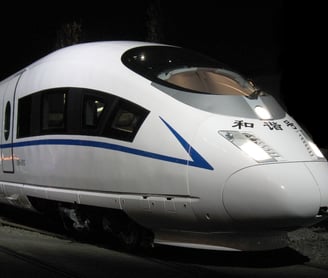


CRH3C. The further localized version CRH380B is also based on this model, and the two are extremely similar. Afterwards, CNR developed multiple types of trains suitable for cold climates and high-altitude environments. For more, see https://en.wikipedia.org/wiki/China_Railway_CRH3
CRH2C. People can easily distinguish between CRH2A and CRH2C based on the differences in the number and shape of their headlights. Image from Wikipedia. For more, see https://en.wikipedia.org/wiki/China_Railway_CRH2#CRH2C_(CRH2-350)
4. Summary And Evaluation
Let's review the timeline of CRRC Sifang's technology introduction:
On July 28, 2004, CSR Sifang and the Japanese consortium jointly bid for the Ministry of Railways' 200 km/h high-speed train project.
In June 2005, CSR Sifang participated in the Ministry of Railways' 300 km/h high-speed train procurement with technical support from Kawasaki Heavy Industries.
On July 31, 2006, the first domestically-produced CRH2A high-speed train was rolled out in Qingdao.
And on December 22, 2007, the first CRH2C high-speed train was rolled out.
How fast is that!
The Ministry of Railways, through two technology introductions using market exchange, achieved remarkable progress in just four years that had taken developed countries decades to accomplish. They successfully obtained high-speed train technology from Japan, France, and Germany at a relatively low cost, demonstrating their smooth and bold approach. This achievement has been recognized as a classic case by Stanford University.
However, technology introduction is only the beginning. The master may open the door, but the practice is up to the student. How to fully digest and absorb the introduced technology, and ultimately turn the high-speed train into a national business card, there was still a long way to go for China's rail transit enterprises. In coming essays, we will talk about how China deeply developed its high-speed railway system, and begun exporting its railway systems and high-speed trains.
Acknowledgements
The contents were originally delivered in a video by "Jiesen Bababa"(杰森bababa)on bilibili.com in 2020.
The Original video was in Chinese. The original video link: https://www.bilibili.com/video/BV1af4y1S72N/?spm_id_from=333.999.0.0
This version is translated by CathayViews Studio, partly assisted by ChatGPT. Some parts has been re-expressed to make it easier to read in English. Some sentences are deleted since we cannot find reliable source.
For any problem about copyrights, please contact us with our email.
